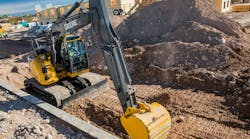When we launched our Running Green series in 2007 to dig into the management ramifications and the mechanics of the then-new diesel emissions standards, we quickly recognized that organizations with construction equipment fleets were in for some changes. We suggested, in fact, that fleets would require specialists in emissions who would direct compliance strategies.
We also asked our readers if they had strategies in place for emissions mnagement. Few did.
Six years later, we stand outside the door to Tier 4-Final implementation, and we find an unsettlingly large percentage of fleet managers still without an emissions-compliance strategy. Benjamin Franklin said, “By failing to prepare, you are preparing to fail.”
Certainly, fleets that are delaying Tier 4 acquisitions have valid reasons for doing that. Prices, existing machine hours on Tier 3 machines, or a switch to a rent-first strategy are methods for dealing with the new engine technologies.
Emissions-Compliance Strategies
Acquiring the latest technology as we replace machines 32% Deferring investment in higher-tiered machines until absolutely necessary 17% Renting compliant machines instead of purchasing 12% Waiting for T4F instead of buying T4I 4% Retrofitting 2% No strategy 43% Source: Construction Equipment
This table shows strategies that our subscribers say they have in place for emissions compliance. About one in three are actively replacing machines with the latest emissions technology. Another 17 percent are sitting tight, holding off on those investments.
But 43 percent of respondents say they have no strategy in place for bringing their fleet into compliance with emissions standards. We can think of a few reasons behind this, all of which contain some level of risk.
- The fleet has low-hour machines and does not operate in nonattainment areas or on projects that require low-emission machines.
- The economy has put a damper on cash flow, so their organization is hunkered down waiting for the market to improve.
- Senior management or—worse—fleet management does not understand how emissions compliance will affect their organization in the near future.
- Management has decided not to worry about it today, compliance is still a long way off.
For those 43 percent, whichever reason may pertain to them, we suggest they spend the remaining months of 2013 determining a strategy. “No strategy” will not succeed.





